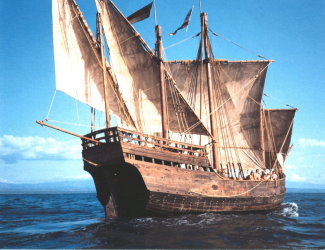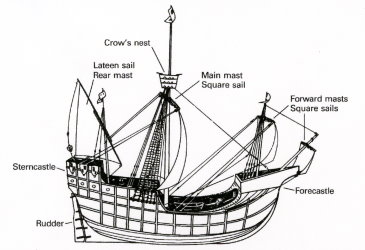The Caravel is the first and most famous ship of the European age of exploration. The caravel comes at the very beginning of the age of sail and of exploration, and is the direct forebear of most European sailing ships.
A caravel is a small, highly maneuverable sailing ship developed in the 15th century by the Portuguese to explore along the West African coast and into the Atlantic Ocean.
The caravel was developed in about 1450, based on existing fishing boats under the sponsorship of Prince Henry the Navigator of Portugal and soon became the preferred vessel for Portuguese explorers.
The caravel gets its name from the shipbuilding term, carvel, which is a method of butting the planking on the hull so that the planks form a tight smooth surface.
Caravels were agile and easy to navigate, with a tonnage of 50 to 160 tons and 1 to 3 masts, with lateen triangular sails allowing tacking into the wind.
Being smaller and having a shallow keel, the caravel could sail upriver in shallow coastal waters. With the lateen sails attached, it was highly maneuverable and could sail much nearer the wind, while with the square Atlantic-type sails attached, it was very fast. Its economy, speed, agility, and power made it esteemed as the best sailing vessel of its time. The limited capacity for cargo and crew were their main drawbacks, but did not hinder its success.


The exploration done with caravels made possible the spice trade of the Portuguese and the Spanish. However, for the trade itself, the caravel was later replaced by the larger nau (carrack) which was more profitable for trading.
The caravel comes at the very beginning of the age of sail and of exploration, and is the direct forebear of most European sailing ships. Caravels discovered America and sailed as far around Africa as China. The Caravel was the transportation technology that enabled Columbus to cross the Atlantic westward to the Americas.
